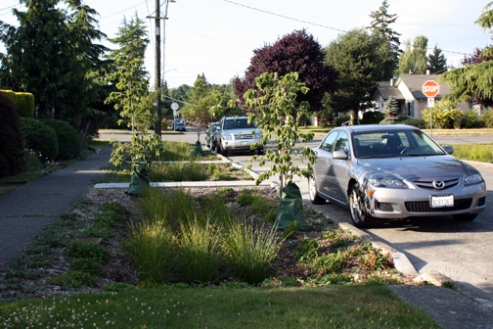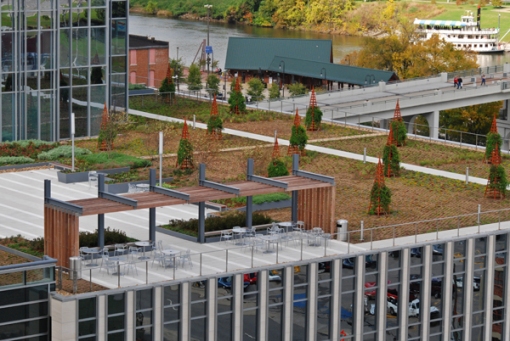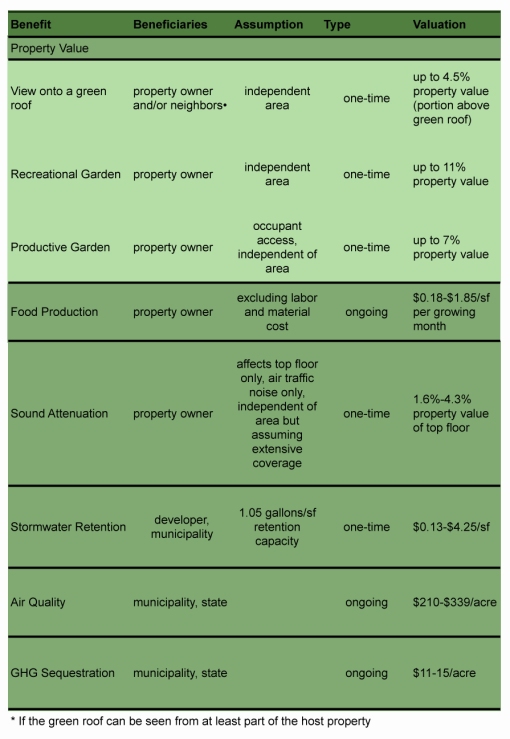
Ballard Roadside Rain Gardens, Credit: Seattle Public Utilities
The City of Seattle was one of the early pioneers of utilizing green infrastructure as a stormwater best management practice with projects primarily concentrated on reducing stormwater flows in various creek basins. Over the last few years, the City has turned its attention to using green infrastructure for controlling Combined Sewer Overflows (CSOs) within the city. While there is currently no consent decree, the City has established a control target of one untreated overflow per outfall per year for CSO discharged based on a 5-year rolling average (Washington Administrative Code (WAC) 173-245). The highest priority for these efforts has been overflows within Lake Washington. Green infrastructure practices are estimated to contribute to this target by controlling 12% of the 16 million gallons needed to be addressed to achieve the City’s goal. The remaining portion will be controlled by conventional grey infrastructure strategies.
The Ballard Roadside Rain Gardens was the first green infrastructure project designed specifically for controlling CSOs. The $1.4 million pilot project was funded by an American Reinvestment and Recovery Act (ARRA) loan and involved installing a series of rain gardens in the right-of-way along eight blocks in the Ballard neighborhood. The rain gardens were installed in December of 2010 and with the expectation that they would reduce discharge volumes by 59,000 gallons or 1% of the the total within the specic NPDES basin. Unfortunately, many of these rain gardens did not perform as anticipated. As a result, over the last few months the project has received negative press and vocal neighborhood opposition over their performance.
The City conducted an extensive post-construction analysis, and determined a third of the rain gardens were not draining and another third were underperforming. The main shortcoming identified was that the geotechnical analysis conducted prior to construction was not specific to each rain garden location and therefore could not account for subtle changes in their infiltration rates. As a result, the underperforming rain gardens did not have sufficient infiltration rates to drain within twenty-four hours and underdrains were not used.
After the post-construction evaluation and a comprehensive community outreach effort, the City took corrective action. The public’s main issues included the dangers of standing water (i.e. drowning, mosquito habitat, smell), steep side slopes of the rain gardens, and their overall aesthetics. The corrective action included removing several of the rain gardens, reducing the depths and steepness of side slopes of others, and adding underdrains where they were effective. These changes resulted in reducing the original estimated CSO volume control by 36%.
The City went further and identified recommendations to improve future implementation of green infrastructure projects. Some examples of their recommendations included the following:
Community Engagement
- Get out into the community early
- Introduce the problem you are trying to solve, before you present the solution
- Utilize several communication media to disseminate information and get feedback.
Planning
- Develop a Project Management Plan (PMP) that outlines roles and responsibilities, schedule, budget, and risks that is approved by management.
Geotechnical
- Integrate geotechnical engineers into all phases of the project and empower them to speak up.
- If the corrected (design) infiltration rate is between 0.25 and 0.5 inches per hour, build a redundant system into the design, such as an underdrain.
Design
- Provide the design for the flow control/bypass plan and erosion and sediment control plan. Do not leave it to the contractor.
- Review project design, how it functions, and the critical project components with Construction Management ahead of time.
Construction
- Balance funding sources with the ability to course correct during construction and the documentation requirements.
- Involve geotechnical engineers in construction to field verify that the excavated or exposed soil look as anticipated.
- Maintain an open dialogue between contractor, construction management, project manager, designer, and geotechincial engineer.
The City of Seattle should be commended for recognizing the shortcomings of the project and taking quick corrective action. The project serves as a reminder of how important the success of pilot projects are to the future of green infrastructure not only locally but also nationally. News travels fast and high profile failures can cast doubt on the effectiveness of these types of systems and fuel future opposition to projects. When approaching any green infrastructure project, the details and execution are crucial to a project’s success, but when the project is intended to set the standard and introduce the public to green infrastructure practices, it becomes even more critical.
-Brian Phelps
Sources:
Email interview with Shanti Colwell, Environmental Engineer with Seattle Public Utilities
Seattle Public Utilities Case Study
Ballard Roadside Raingardens, Phase I-Lessons Learned







You must be logged in to post a comment.